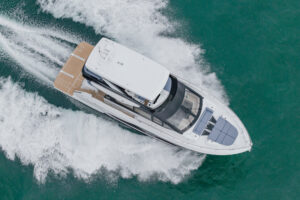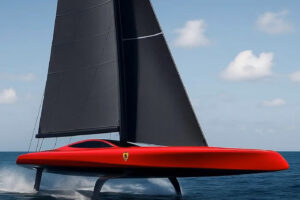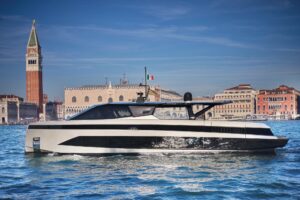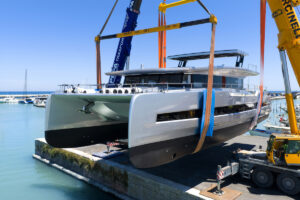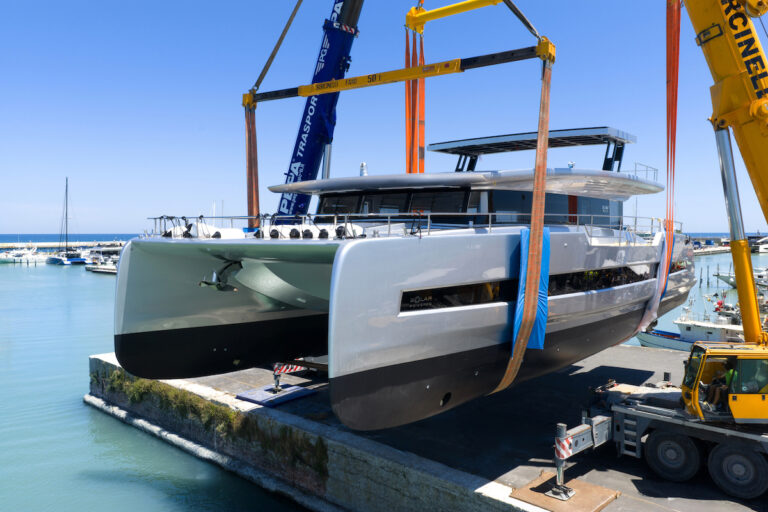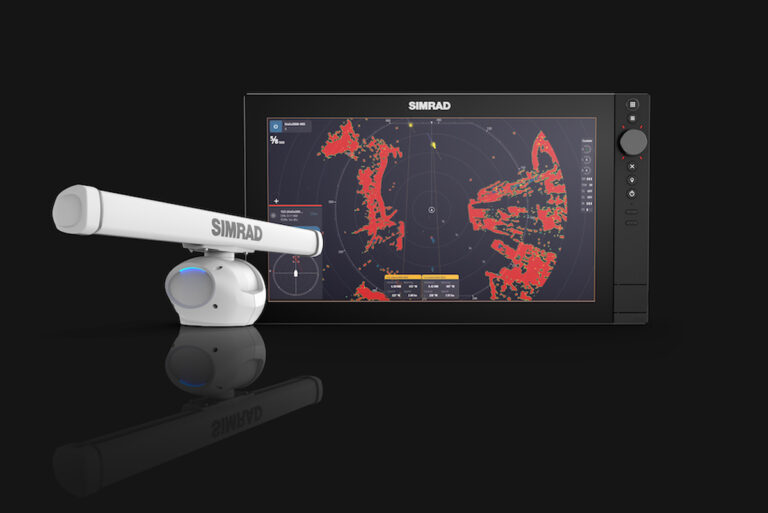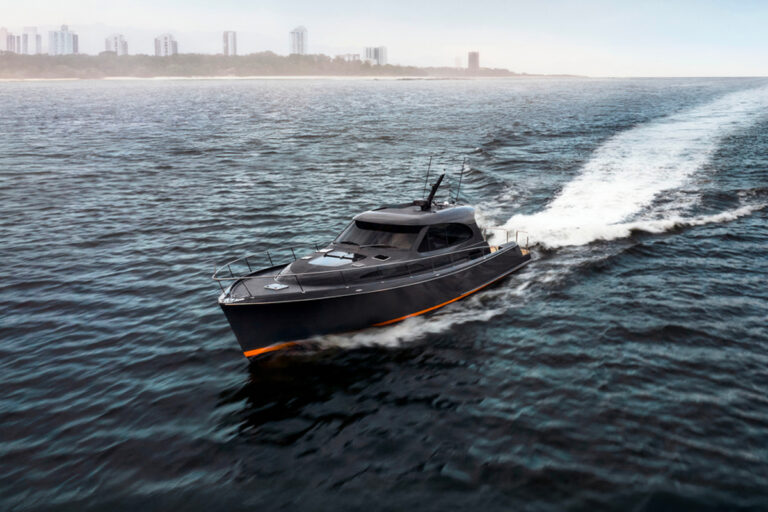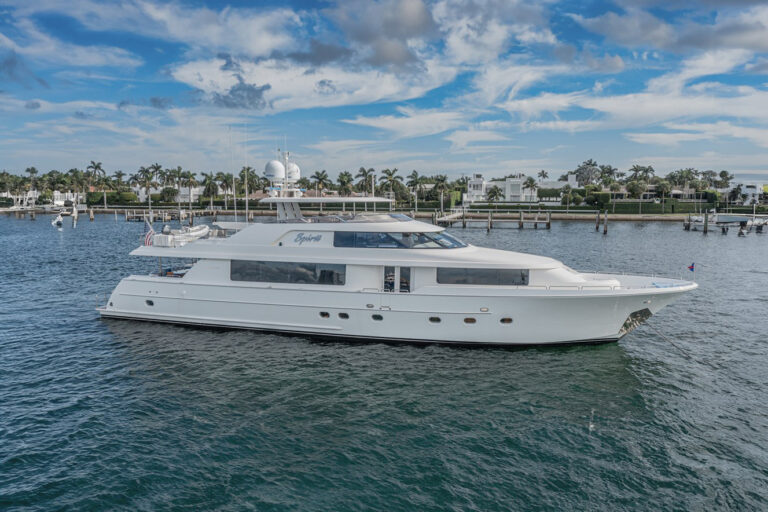
apreamaremae445.jpg
In a world of motoryachts that are all sleek flowing lines with sloping windscreens, the Maestro stands out as a rebel. A vertical windscreen immediately sets this design apart from the others-a nod, perhaps, to Apreamare’s traditional workboat heritage. Yet there’s still the sophisticated Ferretti sensibility that has come to be a hallmark.
This new style lies somewhere between the New England lobster boat and the modern motoryacht. While the Maestro 51 will undoubtably appeal to those seeking something more restrained, it stands out from the crowd in a way that these modern designs seek but seldom achieve.
Once you tear your eyes away from the vertical windows that set the style, you’ll see a hull that flares at the bow, a slight curve in the topsides, and a rounded transom. Below the waterline, the hull is fully modern, its deep-V with a 16 degree deadrise designed to perform. The hull runs aft under the swim platform to achieve the maximum waterline length for good performance and the bow has a sensuous rake that suggests that performance was an important design criteria.

| | |
Above the deck nearly everything is straight lines, dominated by the vertical windows of the pilothouse and the square side windows of the saloon. That’s the profile view, but those pilothouse windows have a beautiful curve in the plan view, stretching in a semi-circle around the helm station. There are more curves in the rear corner windows of the saloon and the subtle arcs of the flybridge and mast also serve to soften any harshness that the straight lines might suggest.
Inside, you’ll appreciate the space and light that the straight lines give. The large saloon windows are powered electrically so that you can open them for fresh air. The interior design is restrained: simple, traditional blue canvas settees with an expanding table on the starboard side, TV and storage lockers to port. Teak wood dominates and is paired with pale cream paneling for a look that is very appealing.
The helm is forward on the starboard side and next to a door that opens onto the side decks. It’s a rather lonely helm-just a single seat. Even a companion standing alongside would have a problem since there’s not much to hold onto. In fact, handholds are a missing feature of this boat and the motion at sea can be quite lively. A main navigation display is flanked by the MAN engine panels; switches and controls are on the flat section in front of the wheel. The wheel is lovely-its teak rim another hint of trawler tradition.

| | |
It feels a bit cramped down below since the steps lead directly into the galley, which, while compact and forming part of a passageway, is still graced with a full four-ring stove with separate grill and oven sections. That passageway through the galley leads aft to a cabin designed primarily for kids, with the lower bunk athwartships and the upper running fore and aft. A proper two-berth cabin is on the starboard side.
And then there is the more generous master cabin forward. While the two aft cabins share a head, the master has one en suite. Once again teak is the dominant wood, matched to cream lacquer and fabric panels. Round portholes make a nice change from the various shaped windows found on competing yachts and they certainly look good from the outside.
The cockpit is spacious but only has two small settees. Mooring fittings are fully enclosed to give a neat look to this area. A tiny one-person crew cabin has been fitted aft against the transom with the entrance under the cockpit settee. Adjacent to this is the passerelle that also serves as a launching davit for a tender stowed on the swim platform. A wonderful visual and aesthetic feature of the design is the wide teak capping around the cockpit and low bulwarks. The side decks are wide and easy to use, giving easy access to the forward sun bed.
The spacious flybridge compensates for the dearth of facilities in the cockpit. There is a bar and barbecue counter, sunbeds, and an ample sitting area. The top helm fits snugly into the port side with all the requirements for navigation. At the aft end is a curved mast that supports the antenna and navigation lights. A low vertical windscreen surrounds the flybridge, following the same curve as the main windscreen below.
For the lower helm, however, while you’d think there would be excellent visibility with all those large windows, in fact the saloon windows are set too low for a good view.
Twin MAN diesels that each produce 730 hp are enough to give the Maestro useful performance with speeds up to 30 knots. The speed seems appropriate, certainly as fast as is reasonable for this style of yacht. Ease back a notch and the ride becomes very comfortable-you can cruise all day at 25 knots. The test boat was fitted with the optional Anti-Rolling Gyro (ARG) but this takes some time to get up to speed so it was not fully operational on the sea trial. Past experience with the ARG suggests that it will produce a very comfortable ride when underway and keep the boat level when at anchor.
Don’t make the mistake of thinking that this good-looking boat shirks on performance. It works very well at sea. In the short steep seas encountered off the South of France where we ran the sea trial, the Maestro lived up to its name. It performed well, coping with conditions in a way that made you feel it was a much larger yacht.
Maneuvering in harbor was simple and straightforward with the bow thruster doing its job very nicely. As with everything else on this boat, it worked as you’d expect and there were no unpleasant surprises.
To be honest, my first reaction to the Maestro 51’s styling was that this was just a designer’s gimmick-an attempt to somehow make the Apreamare look different. After becoming more closely acquainted with the boat, however, I saw that this styling was more than skin deep.
Now I love the concept. It works well, it performs predictably, and it has considerable character and charm, features so often lacking in modern designs. The Maestro may not fall comfortably into a single neat category with its blend of trawler and sports yacht. But like a conductor who brings together an entire orchestra, the whole, in this case, is definitely more than the sum of its parts.

